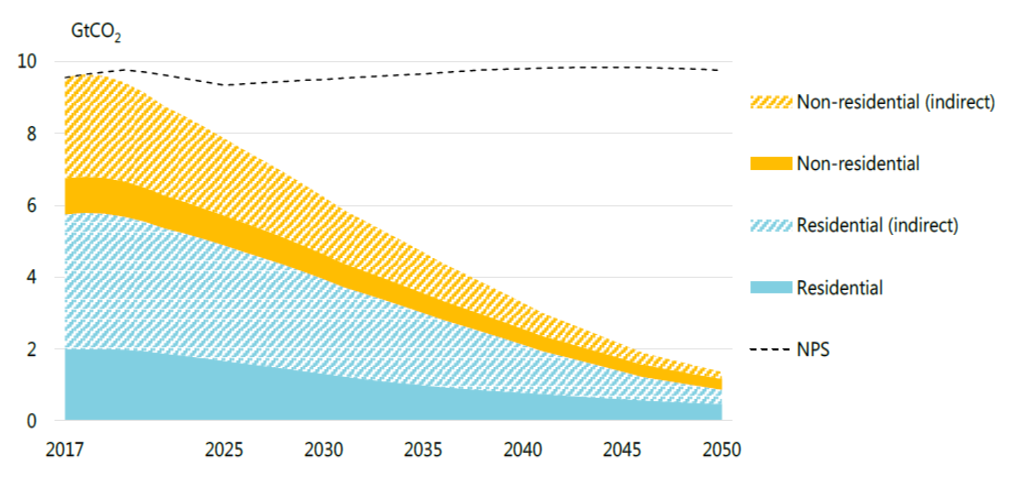
Equity
The Future of Real Estate Is Sustainable
Back to all
As an upheaval fueled by regulatory pressure looms in the real estate sector, ESG aspects are set to become highly material. The companies that have best anticipated these Sustainability trends will be the winners of tomorrow.
Sustainability & Real-Estate strategies did not go together until recently
Historically, real-estate investment strategies and Sustainable Investment did not seem to go well together. During the early two-thousands, many asset managers involved in Sustainable and Responsible Investment (SRI) were still relying on Best-In-Class or Best-In-Universe investment processes usually based on ESG scores sourced from external ESG rating agencies, and which simply exclude the worst scored companies. These approaches suffered two main shortcomings: the ESG scores were often not available for smaller real-estate issuers (ESG rating agencies simply did not cover them), and when they were available, they often suffered several significant biases. Typically, smaller real-estate companies tended to score poorly, leading to their exclusion from investment portfolios. Conversely, larger real-estate companies were often the only ones providing sufficient ESG reporting for ESG rating agencies to score them, and they generally obtained the highest ESG scores. This made stock selection difficult, depriving portfolio managers from interesting investment opportunities, and making ESG screenings less attractive. As a consequence, many asset management firms renounced applying Sustainability approaches, and the offering of Sustainable Real-Estate strategies remained limited.
This is changing now
Yet, for a few years now, things have been changing within the real-estate sector. Confronted with a growing regulatory pressure (energy-efficient construction standards, green-building certificates…), and with more frequent questions from investors, most real-estate companies are now improving their extra-financial reporting, and provide more transparency. This is facilitating the work of ESG analysts within ESG rating agencies and asset management firms, thus making it easier to set-up Sustainable Real-Estate strategies. As the total amount of Assets-Under-Management (AUM) invested in Sustainable Real Estate strategies is growing, these companies are increasingly encouraged to align themselves with Sustainability requirements. This way, a virtuous circle is being progressively established, for the benefit of the real-estate sector, Sustainable investors, and our society as a whole.
First the Environmental and Governance pillars, and finally the Social
At first, this positive trend impacted the Environmental pillar. Following several national regulations on the energy performance of buildings over the last fifteen years, every real-estate company has had to improve the energy-performance of the buildings it manages or develops. Besides, energy-efficiency and carbon emissions data are becoming more readily available, and such ESG Key Performance Indicator (KPI) can be used to provide a basis for comparison among similar real-estate companies. In the same way, quantitative metrics may be used to assess the proportion of “green-buildings” operated by a real-estate company, the energy-efficiency of its assets, its consumption of water, its waste generation, etc. As the availability of environmental KPIs improves, ESG-oriented investors are able to better identify Sustainable investment opportunities, and so, to invest in the best positioned companies for a future low-carbon World.
Governance aspects are both important and potentially material for real-estate companies. In many real-estate companies, the founder remains an important shareholder and is often managing the company too. In this context, a responsible investor should pay specific attention to the protection granted to minority shareholders’ rights, and more specifically to the independency ratio of the board and of its committees, the structure of the remuneration of the auditors, the rules governing capital issuance, the presence of related-party transactions, or any deviation from a single share-class structure. In the same way, responsible investors can reduce the risks of fines and adverse court decisions by requiring effective anti-corruption policies from companies. A well designed whistleblower system, and some training effort, may help mitigate these legal risks. By correctly anticipating these risks, a Sustainability approach may help reducing unwanted volatility in the investment portfolio.
The Social pillar has a reputation of being harder to analyse from a Sustainability point of view, mainly because quantitative KPIs are less often available. Yet, key aspects such as customer satisfaction (e.g. relations with tenants), relations with local communities and authorities, or the management of human capital, are relevant and financially material to real-estate companies. By nature, real-estate assets must be well integrated in their environment, from a physical point of view but also with regard to its stakeholders. Good relations with local authorities and tenants are necessary for real-estate companies to keep their “licence to operate”, and to pursue their future development. Therefore, real-estate companies willing to succeed in the long-run must also deliver on social performance. By selecting the real-estate companies with the strongest ESG fundamentals, Sustainable and Responsible Investors are reducing risks and preparing their investment portfolio for the “World of tomorrow”.
The materiality is coming
And this “World of tomorrow” may well be coming sooner than many believe. In Europe, regulations on the energy-efficiency of buildings already are much more stringent today than they were a decade ago. For instance, following the Energy Performance of Buildings Directive (EPBD recast)1, all new buildings in the EU shall be nearly “zero energy” by the end of this year.
However, these regulations are not sufficient, and the real-estate industry should expect even stronger norms and incentives in the near future. Today, buildings account for grossly 40% of man-made emissions of greenhouse gases 2. In spite of the progress made on building efficiency, greenhouse gas emissions from buildings are still rising globally by grossly one percent per year, following global demographic trends and the increasing share of the world’s population with access to improved housing. In order to achieve a growth of temperature below 2 degrees globally, the building sector must cut its global emissions by 85% by 2060 over current levels 3. The EU currently follows a -30% trend 4, and other regions of the World are lagging behind. Also, in a “business as usual scenario”, greenhouse gas emissions from buildings could double or triple by 2050 5. This shows that the current pace of efforts is clearly insufficient to mitigate the future impact of Climate Change. Evidently, there is a high likelihood of strong government intervention and a further tightening of buildings’ Energy-Efficiency Standards is expected in Europe and beyond.
Buildings-related CO2 emissions in the Faster Transition Scenario 2017-2050 from the IEA (IEA 2019)

Source: International Energy Agency, Perspectives for the Clean-Energy Transition, The critical role of buildings, April 2019
This could make a significant share of current properties un-rentable, resulting in stranded assets. For instance in the UK, from April 2030, all leased office buildings will have to achieve an Energy Performance Certificate (EPC) of either “B” or “C” (the Government still is to set the standard). In the most conservative “C” scenario, up to 50% of the current office stock in the UK would be impacted7. Real-Estate landlords would have to invest an estimated 2.8 billion Euros in energy efficiency renovations, only in order to keep these buildings on the market. And further efforts will be required during the 2030-2050 period. At the EU level, it is more than a tripling of the current rate of building energy-renovation which is needed in order to achieve EU 2050 carbon objectives8. Hence, the European Real-Estate sector as a whole is facing a very impacting challenge, and significant CAPEX will be needed, only to ensure business continuity.
Investing in future winners and contributing to a healthier planet
The real estate sector will have to evolve at a forced pace. This is an opportunity for the most advanced players on the path toward the energy transition. As a result, companies that fall behind and whose buildings exhibit insufficient energy performance, are taking the risk of a deterioration in the value of their assets, or even the risk of stranded assets, as future regulations may simply prohibit renting poorly energy-efficient buildings. Similarly, companies which fail to ensure their buildings’ resilience to climate events (i.e. climate change physical risks such as flooding, heat-waves and storms), may face increased insurance costs, a reduced attractiveness of the buildings, and therefore a deterioration in their values. On the social pillar, real-estate companies that ensure a high quality of service, apply reasonable pricing and have a robust process to address tenant concerns are more likely to achieve high occupancy rates, and to safeguard their license to operate. Regarding Governance, companies that best respect minority shareholders’ rights, and apply remuneration packages incentivizing long-term performance, may be more appealing to investors.
As an upheaval in the real estate sector fueled by regulatory pressure looms, ESG aspects are set to become highly material. The companies that have best anticipated these Sustainability trends will be the winners of tomorrow, and constitute the investment opportunities of today. Certainly, the future of Real-Estate will be Sustainable.
Disclaimer
Degroof Petercam Asset Management SA/NV (DPAM) l rue Guimard 18, 1040 Brussels, Belgium l RPM/RPR Brussels l TVA BE 0886 223 276 l
Marketing Communication. Investing incurs risks.
The views and opinions contained herein are those of the individuals to whom they are attributed and may not necessarily represent views expressed or reflected in other DPAM communications, strategies or funds.
The provided information herein must be considered as having a general nature and does not, under any circumstances, intend to be tailored to your personal situation. Its content does not represent investment advice, nor does it constitute an offer, solicitation, recommendation or invitation to buy, sell, subscribe to or execute any other transaction with financial instruments. Neither does this document constitute independent or objective investment research or financial analysis or other form of general recommendation on transaction in financial instruments as referred to under Article 2, 2°, 5 of the law of 25 October 2016 relating to the access to the provision of investment services and the status and supervision of portfolio management companies and investment advisors. The information herein should thus not be considered as independent or objective investment research.
Past performances do not guarantee future results. All opinions and financial estimates are a reflection of the situation at issuance and are subject to amendments without notice. Changed market circumstance may render the opinions and statements incorrect.